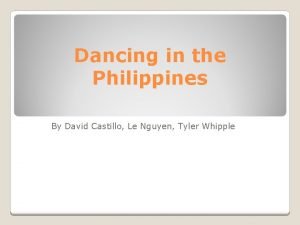Philippian Tinikling History of Tinikling The name tinikling




- Slides: 4

Philippian. Tinikling

History of Tinikling The name "tinikling" is a reference to birds locally known as tikling, The dance imitates the movement of the tikling birds as they walk between grass stems, run over tree branches, or dodge bamboo traps set by rice farmers. Dancers imitate the tikling bird's legendary grace and speed by skillfully maneuvering between large bamboo poles. Legend has it that tinikling originated during the Spanish rule of the Philippines, when natives worked on large plantations under the control of the King of Spain. Those who didn't work productively were punished by standing between two bamboo poles Tinikling is commonly performed on special occasions such as the Filipino Independence day as a celebration of Filipino culture and Filipino pride. The dance is good for hand coordination, foot speed, and also rhythm

The Tinikiling involves two people beating, tapping, and sliding bamboo poles on the ground. Two dancers steps over and in between the poles to dance

Props: Bamboo Sticks The bamboo is used as a percussive instrument as it is banged against the ground (or a piece of wood to make it easier to hold) and each other in a pattern. The bamboo has to be closed hard enough to make a sound, and the dancers must be quick enough to not get their foot (or feet) caught. As the dance continues, the banging of the bamboo becomes faster and harder, the sound of the clashing bamboo and the quickness of feet demonstrated by the dancers thrilling the crowd.







